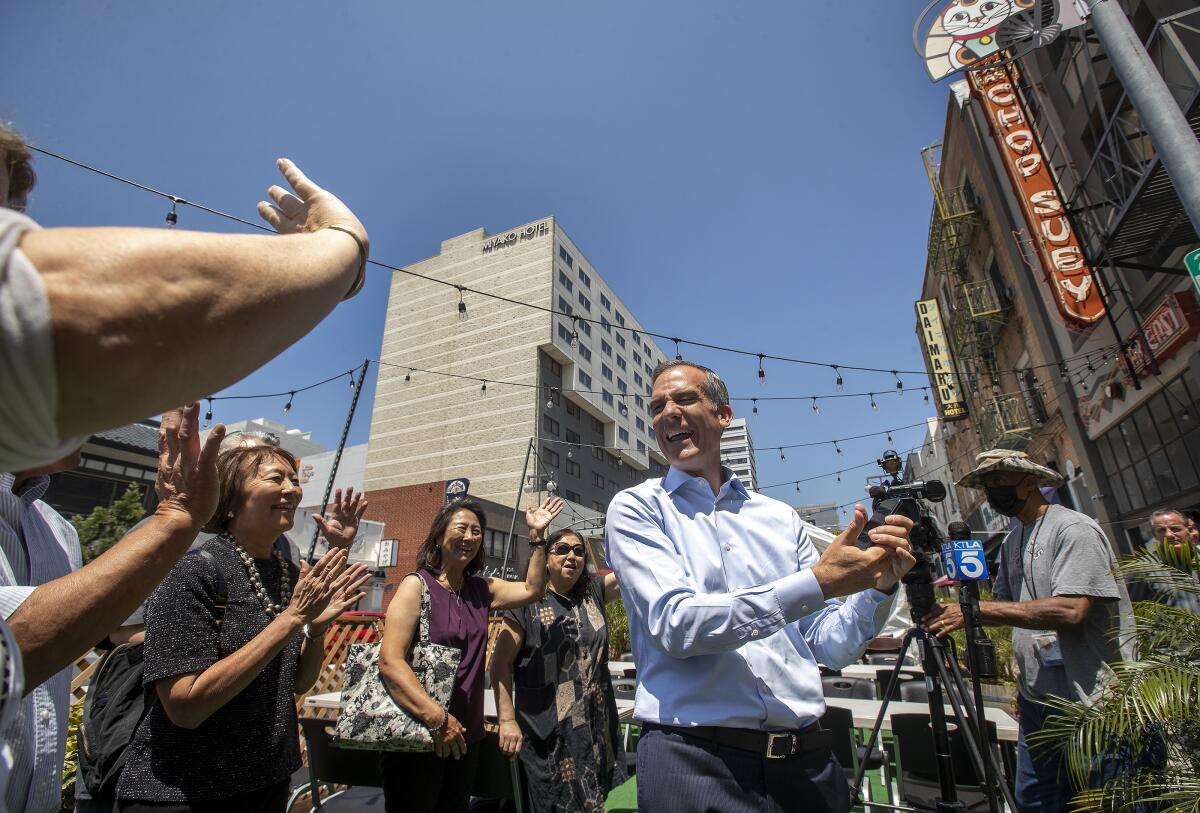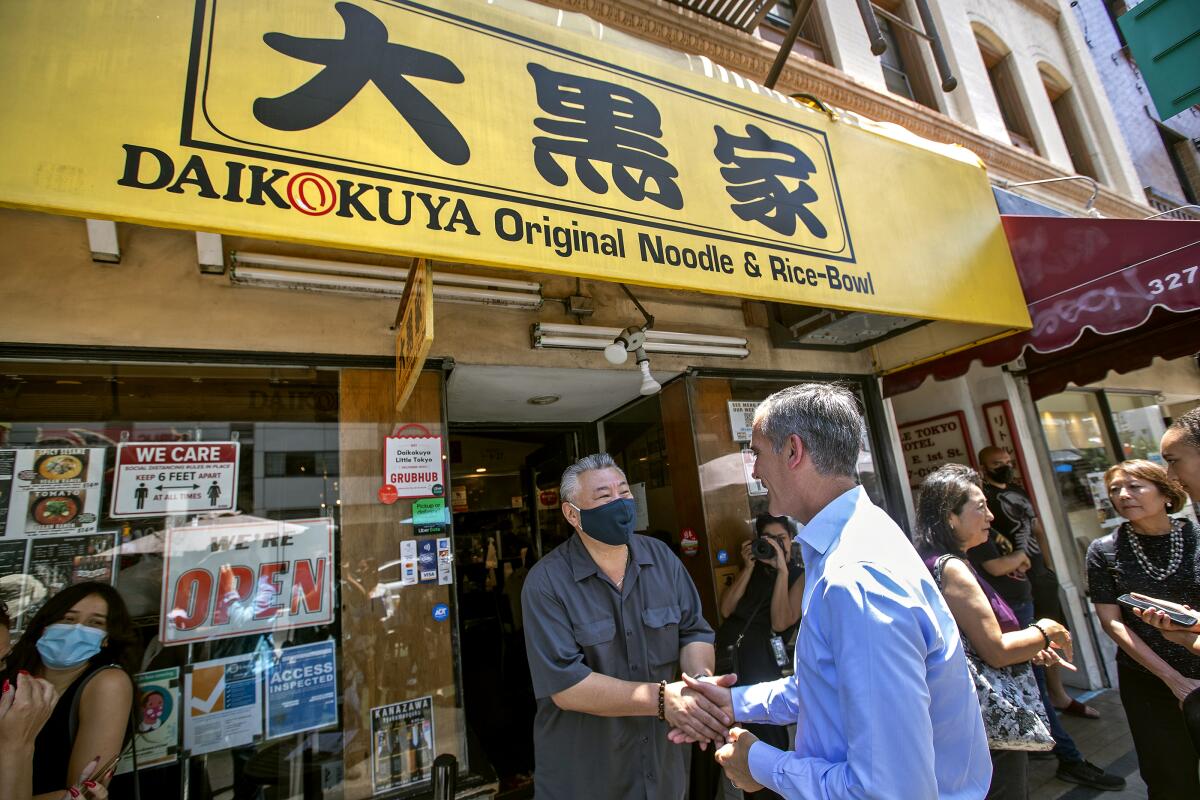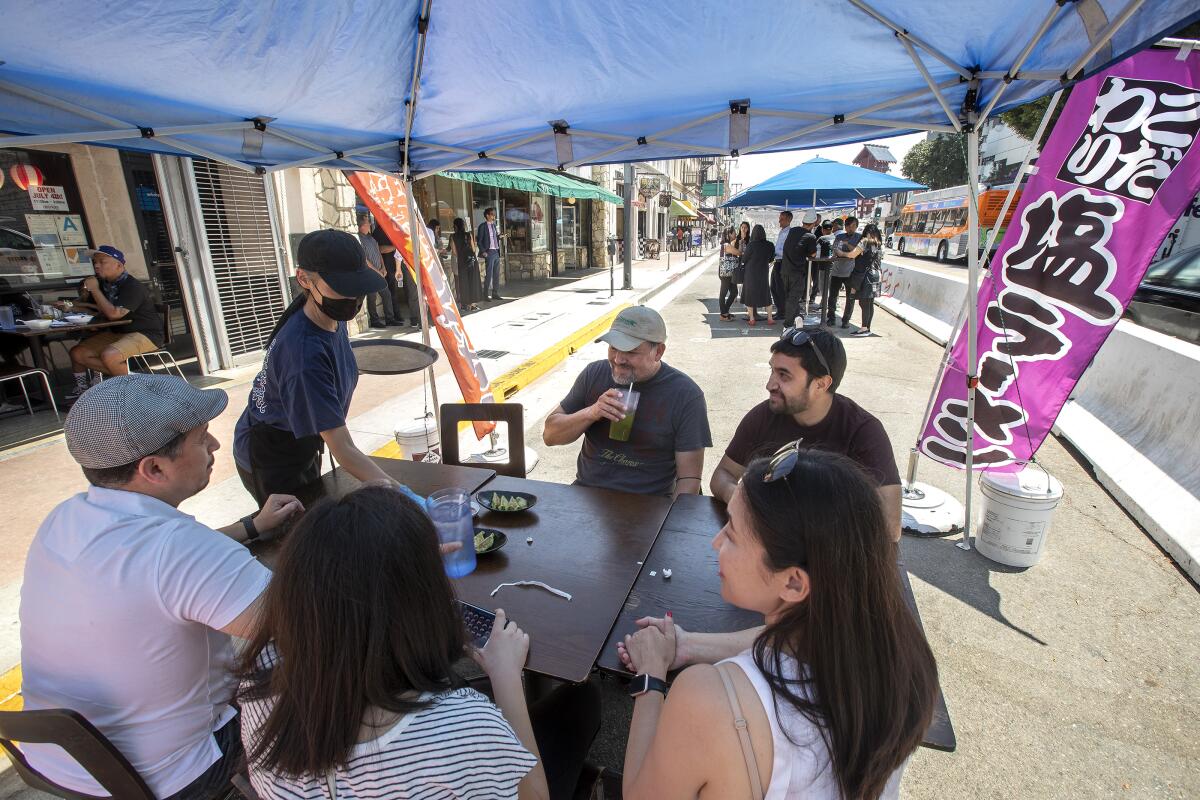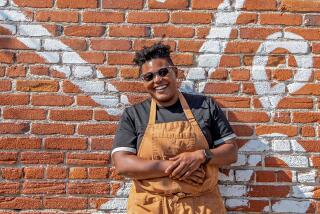COVID-19 ravaged L.A. restaurants. Will permanent outdoor dining help save them?

- Share via
As COVID-19 decimated the Los Angeles restaurant industry, downtown’s Little Tokyo found itself particularly hard hit, as did similar enclaves of mom-and-pop eateries. Language, cultural and technological barriers made it difficult for some to adjust to the pandemic realities of delivery and takeout. Bottom lines shrank severely.
Now, Little Tokyo’s 1st Street is filled with people eating on tables extending past the curb into the street. The street’s eastern block has become a hub for alfresco dining, thanks to an L.A. city program that let restaurants offer outdoor seating during the pandemic, and which officials are considering making a permanent fixture in the city at large.
Created under the mayor’s emergency authority in May 2020, the program, called L.A. Al Fresco, allowed restaurants to expand outdoor dining onto sidewalks, parking lots and sections of city streets. These authorizations aren’t slated to last indefinitely, leaving diners and restaurant workers wondering about the long-term future of outdoor dining in L.A.
Mayor Eric Garcetti, who toured Little Tokyo on Wednesday to talk to restaurant owners, said his office was focused on making a permanent program uniform across the city, and more disability friendly.
The mayor’s office is working on rules that can be as simple as possible for local businesses to follow, although historic districts may need slightly different rules to maintain building facades. “I don’t want a restaurant owner who has four branches of her restaurant to have to do four different things,” Garcetti said in an interview.
City officials hope to have a permanent Al Fresco program in place by the fall. New York City has already announced a timeframe for making its outdoor dining initiative, Open Restaurants, permanent.
Garcetti said he wants to preserve the relaxed valet and offsite parking requirements that have freed up valuable curbside real estate for outdoor dining setups. “Why do we need to take these spots and have six cars here when we could have 100 people here?” he said.

The mayor’s office is also working with the department to introduce regulations to make permanent alfresco setups more disability friendly, which has been a concern as businesses claim larger portions of sidewalk space.
The last 16 months have eviscerated California’s restaurant industry. One million jobs were lost, and as many as 30% of restaurants in the state were forced to permanently close due to the pandemic, according to findings of a state Senate pandemic response committee.
Small businesses suffered severely. Legacy mom-and-pop businesses such as Suehiro Cafe and Kouraku faced language and cultural hurdles applying for the limited aid available to small businesses. Some had little or no social media presence and were unfamiliar with online delivery apps. The owner of Suehiro Cafe, Kenji Suzuki, estimated that his business took a 90% hit at the beginning of the pandemic.
L.A.‘s temporary authorizations for restaurants, initially granted for 90 days, have been extended through Sept 1, though officials said the current Al Fresco program will remain in place until 90 days after Garcetti’s emergency order ends. The City Council voted in May to explore the possibility of making the program permanent by ordering a series of reports from different city agencies, including the Bureau of Engineering and Department of City Planning, about its feasibility.
The ability to serve customers outdoors was a lifeline for many.
Takaaki Kohyama, who owned four businesses in Little Tokyo before the pandemic, said the addition of alfresco dining has saved his business, though he has still downsized. “It was a very big help [to] us,” he said.
The addition of outdoor dining continues to make his ramen restaurant, in particular, feel accessible, Kohyama said. With state rules lifted and indoor dining permitted again, some patrons still only feel comfortable eating outside, especially with growing concerns over the Delta variant.
Brian S. Kito, owner of Fugetsu-Do confectionery and bakery — a neighborhood institution that has been on the same block since 1903 — has advocated for outdoor dining in the area since the start of the pandemic. Kito said he helped secure outdoor dining permission for the entire 1st Street thoroughfare, where his shop is located, leaning on his experience as a member of the neighborhood council to deal with city officials.
His bakery is entirely indoors, and Kito said there was little personal benefit to him from the program: He gave over his parking lot for others to use as outdoor dining space. “I personally for my business need parking, but I knew if these restaurants didn’t get some outdoor dining that they were going to die. And I thought, ‘I don’t want to come out of this with no neighbors,’” he said. “In the end, I think all the restaurants benefited.”

The city’s Al Fresco dining program has been one of few bright spots during a difficult year muddled by sometimes ineffective or contradictory guidance released by the state, county and city.
Relaxed parking space requirements under the program have helped restaurateurs expand seating into parking lots (generally, one space was required per 100 square feet for restaurants that have 1,000 or more square feet of floor space). And the loosening of Department of Alcoholic Beverage Control restrictions has made it easier to serve alcohol outdoors.
Sandra Cordero, chef-owner of Gasolina Cafe in Woodland Hills, said the streamlining of outdoor dining regulations has made her life considerably easier, allowing her to put five tables outside her restaurant. “I talk to a lot of my peers, and it’s been good for a lot of people. It’s really helped. But even in the future, we still really need this.”
Without the program, she said, she would not have been able to obtain an outdoor dining permit nearly as quickly.
“Our customers really enjoy it,” she said. “I don’t understand why the rules are so ridiculously strict here.”
More to Read
Inside the business of entertainment
The Wide Shot brings you news, analysis and insights on everything from streaming wars to production — and what it all means for the future.
You may occasionally receive promotional content from the Los Angeles Times.












